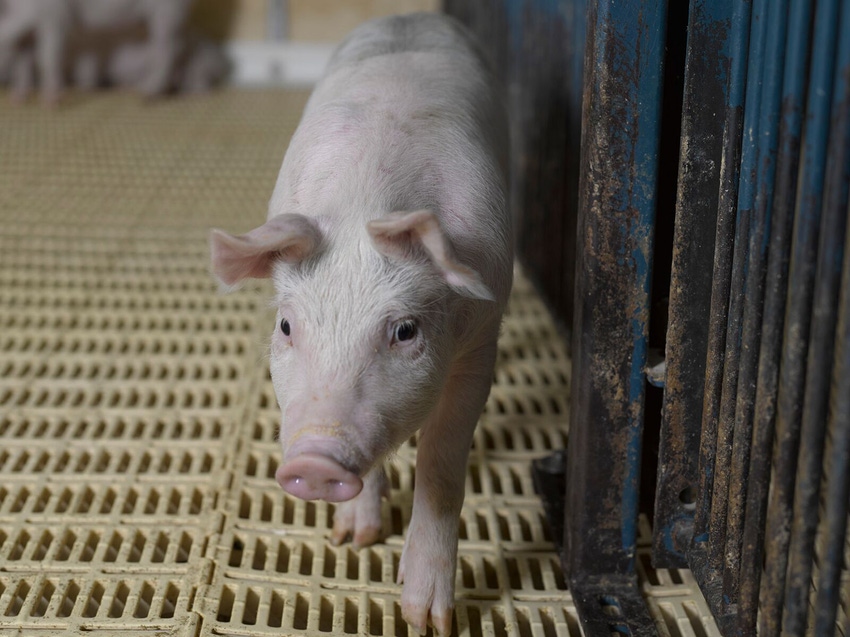When trying to decrease the virus challenge to a piglet, it is first necessary to figure out where the virus is outside the pig, how it moves around the farm.
June 6, 2023

When asking the question, "How can influenza be controlled on a pig farm?" the first thing that comes to mind is "vaccines." The second thing is probably "gilts" and the third is "people." That order for answering the question is perfectly understandable given the evidence that shows that vaccines, particularly vaccines in sows, are commonly used on pig farms to protect piglets from influenza. Gilts and people are also important because both can be sources of new strains into farms, and gilts can be amplifiers of existing infections. All this translates into the need to have a comprehensive multi-prong approach to controlling influenza.
However, one side of the equation that is often forgotten is the need to decrease the viral challenge to susceptible populations such as newborn piglets. Piglets are born negative for influenza infections and piglets in endemically infected farms become infected rapidly prior to weaning. Unfortunately, even piglets born to vaccinated sows may become infected. Whether or not a piglet farrowed by a vaccinated sow becomes infected depends on how well the vaccine matches the influenza strains circulating in the herd. Both the quality and quantity of the immune response matters. When you understand that vaccination, that "No. 1 thing to control disease," is imperfect, it makes you realize how important it is to decrease the viral challenge by other methods.
When trying to decrease the virus challenge to a piglet, it is first necessary to figure out where the virus is outside the pig and how it moves around the farm. Keep in mind that influenza is very contagious! The virus can be found on many surfaces around the farm (e.g., pen railings, floors, walls, hallways, etc.) and the virus can also be found on many materials that come in contact with piglets, particularly those used to handle the pigs.
In a study by Lopez et al., (1) influenza was detected in 46% of samples collected from carts and tools used during processing, and a common and somewhat surprising finding was to see how often it was detected on the hands and coveralls of employees (58%). The likelihood of detection was higher if the worker had been performing chores involving weaning piglets. It has been known for many years that influenza prevalence during the weaning period tends to be high (2).
Lopez et al (3) revealed that chores such as pre-weaning vaccinations and even the weaning process itself resulted in significant contamination of the workers’ hands and coveralls, and the virus was often viable and capable of spreading pig to pig. If these workers then perform other farm chores such as piglet processing, or vaccinating gilts, it is then very likely that they could transmit influenza. Transmission of influenza through contaminated hands and coveralls (i.e., fomites) has been shown experimentally (4) and it did not take much to transmit influenza via fomites. Thus, a recommendation from our studies is the need to change coveralls and wash hands after completing high-risk tasks such as weaning pigs - especially when these tasks take place first thing in the morning.
A question that comes to mind then is, "How should people wash their hands to prevent spreading influenza from pig to pig?" We set out to answer this question by comparing four hand hygiene protocols: a) washing with water only, b) washing with soap and water, c) using an alcohol-based hand sanitizer or, d) wearing gloves. After handling influenza-infected pigs for 10 minutes, study participants followed one of the hand hygiene protocols, and their hands were tested for influenza by RT- PCR before and afterwards. The results indicated that all hand hygiene protocols were useful at removing some virus from the hands, but only the use of the alcohol-based sanitizer and wearing gloves were effective at eliminating or preventing the contamination of hands with influenza virus. Washing hands with soap and water was not enough to eliminate the virus from hands. Think twice when washing hands, and consider using a squirt of an alcohol-based sanitizer, including after taking a shower.
So, back to the question on what to do to control flu, don't forget about simple things such as to how to properly follow hand hygiene practices, change coveralls and clean the environment. These things, although not fancy and technical, will decrease virus challenge to piglets and lower the likelihood of becoming infected in the first place. These basic practices will not only help the pigs but will also help decrease the risk of influenza transmission between pigs and workers.
References:
Lopez-Moreno G, Garrido-Mantilla J, Sanhueza JM, Rendahl A, Davies P, Culhane M, McDowell E, Fano E, Goodell C, Torremorell M. Evaluation of dam parity and internal biosecurity practices in influenza infections in piglets prior to weaning. Prev Vet Med. 2022 Nov;208:105764. doi: 10.1016/j.prevetmed.2022.105764. Epub 2022 Sep 21. PMID: 36181751.
Chamba Pardo, F. O., Alba-Casals, A., Nerem, J., Morrison, R. B., Puig, P., & Torremorell, M. (2017). Influenza Herd-Level Prevalence and Seasonality in Breed-to-Wean Pig Farms in the Midwestern United States. Frontiers in veterinary science, 4, 167. https://doi.org/10.3389/fvets.2017.00167
Lopez-Moreno G, Culhane MR, Davies P, Corzo C, Allerson MW, Torremorell M (2023). Farm management practices associated with influenza A virus contamination of people working in Midwestern United States swine farms. Accepted for publication. Porcine Health Management.
Allerson MW, Cardona CJ, Torremorell M. Indirect Transmission of Influenza A Virus between Pig Populations under Two Different Biosecurity Settings. PLoS One. 2013 Jun 21;8(6):e67293. doi: 10.1371/journal.pone.0067293. PMID: 23805306; PMCID: PMC3689715.
You May Also Like



